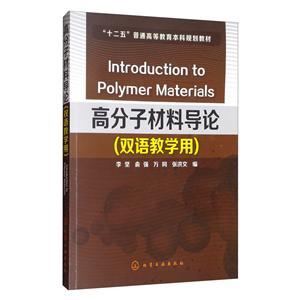Chapter 1 Introduction1
1.1 Classification of polymerizations1
1.1.1 Condensation and addition polymerization1
1.1.2 Step and chain polymerizations3
1.2 Classification of Polymers5
1.2.1 Classification by source5
1.2.2 Classification by mechanical behavior and application5
1.2.3 Classification by synthesis reaction6
1.2.4 Classification by chain structure6
1.2.5 Classification by processing characteristics7
1.3 Physical State, Property and Application of Polymers8
1.3.1 Crystalline and amorphous behavior8
1.3.2 Thermal transitions8
1.3.3 General properties of polymers9
1.3.4 Applications of polymer materials10
1.4 Polymer Processing10
1.4.1 Ingredients of polymer materials11
1.4.2 Processing methods11
1.5 Development of Polymer Science and Engineering13
1.5.1 Brief history of polymer materials13
1.5.2 Establishment of polymer science14
1.5.3 The development of synthetic polymers14
Problems19
Chapter 2 Polymer Synthesis20
2.1 Step Polymerization20
2.1.1 Basis for analysis of polymerization kinetics21
2.1.2 Kinetics of step polymerization22
2.1.3 Molecular weight control in linear polymerization28
2.2 Radical Chain Polymerization33
2.2.1 Rate of radical chain polymerization33
2.2.2 Molecular weight38
2.2.3 Chain transfer40
2.2.4 Inhibition and retardation42
2.2.5 Process conditions43
Problems47
Chapter 3 Polymer Structure, Molecular Motions and Transitions of Polymers50
3.1 General Introduction for Polymer Structures50
3.1.1 Structural groups50
3.1.2 Linear chain polymers51
3.1.3 Configurations of polymer chains53
3.1.4 Conformation55
3.1.5 Copolymers55
3.1.6 Network polymers56
3.2 Characteristics of Macromolecular Motions and Transitions56
3.2.1 The Glassy Region57
3.2.2 The Glass Transition Region57
3.2.3 The Rubbery Plateau Region58
3.2.4 The Rubbery Flow Region59
3.2.5 The Liquid Flow Region59
3.3 Molecular Motion and Thermal Transitions59
3.3.1 Theories of glass transition60
3.3.2 Factors affecting glass transition temperature62
3.3.3 The crystalline melting point69
3.3.4 Factors affecting the crystalline melting point, Tm70
Problems74
Chapter 4 Solid State Properties of Polymers76
4.1 Mechanical Properties76
4.1.1 Forces Versus Deformation Properties77
4.1.2 Toughness83
4.1.3 Creep87
4.2 Optical Properties88
4.2.1 Haze88
4.2.2 Transparency89
4.2.3 Gloss90
4.3 Surface Contact Properties90
4.3.1 Friction90
4.3.2 Cling92
4.3.3 Wear Resistance92
4.4 Barrier Properties93
4.4.1 Permeation through Polymers94
4.4.2 Barrier Property Analysis95
4.5 Electrical Properties96
4.5.1 Electrical Resistance96
4.5.2 Capacitive Properties97
4.5.3 Dielectric Strength98
4.5.4 Arc Resistance99
4.5.5 Corona Treatment99
4.5.6 Factors Influencing Polymers in Electrical Applications99
4.6 Weather Resistance100
4.6.1 Natural Outdoor Weathering100
4.6.2 Accelerated Outdoor Weathering101
4.6.3 Artificial Weathering101
Problems101
Chapter 5 Characterization and Testing of Polymers103
5.1 Gel Permeation Chromatography103
5.1.1 GPC Instrumentation103
5.1.2 Calibration105
5.1.3 Selection and Assembly of Detectors106
5.2 Infrared Spectroscopy106
5.2.1 Instrument and Experimental Method107
5.2.2 Applications to Polymers108
5.3 X-ray Diffraction Analysis110
5.3.1 Experimental Methods110
5.3.2 Application to Polymers111
5.4 Nuclear Magnetic Spectroscopy112
5.4.1 Experimental Methods112
5.4.2 Application to Polymers113
5.5 Thermal Analysis118
5.5.1 Thermogravity Analysis (TGA)118
5.5.2 Differential Scanning Calorimetry (DSC)119
5.6 Light and Electron Microscopy122
5.6.1 Light Microscopy122
5.6.2 Electron Microscopy123
Problems126
Chapter 6 Plastics128
6.1 Polyethylene128
6.1.1 Low Density Polyethylene (LDPE)130
6.1.2 High density polyethylene (HDPE)134
6.1.3 Linear low density polyethylene (LLDPE)135
6.1.4 Ethylene-vinyl acetate copolymer (EVA)136
6.1.5 Crosslinked polyethylene (XPE)137
6.2 Polypropylene (PP)137
6.2.1 Isotactic polypropylene138
6.2.2 Syndiotactic polypropylene (sPP)139
6.3 Polyvinyl Chloride (PVC)140
6.3.1 Polymerization140
6.3.2 Structure and Properties141
6.3.3 Copolymers142
6.3.4 Application142
6.4 Polystyrene (PS) and Related Polymers143
6.4.1 Polymerization of styrene143
6.4.2 Structure and properties143
6.4.3 Copolymers of styrene144
6.4.4 Syndiotactic polystyrene (sPS)145
6.4.5 Application145
6.5 Polymethyl Methacrylate (PMMA)146
6.5.1 Polymerization146
6.5.2 Structure and property146
6.5.3 Application147
6.6 Polyamide (Nylon)147
6.6.1 Polyhexamethylene adipamide (nylon-66)147
6.6.2 Other important polyamides149
6.7 Polyethylene terephthalate (PET)150
6.7.1 Polymerization150
6.7.2 Property and application150
6.8 Polyoxymethylene (POM)151
6.8.1 Polymerization151
6.8.2 Property152
6.8.3 Application152
6.9 Polycarbonate (PC)152
6.10 Polytetrafluoroethylene (PTFE)152
6.10.1 Polymerization153
6.10.2 Structure153
6.10.3 Property154
6.10.4 Effect of structure on property154
6.10.5 Fabrication and processing154
6.10.6 Application156
6.10.7 Fluorocarbon copolymers156
Problems156
Chapter 7 Elastomers158
7.1 Basics for Elastomers158
7.2 Morphology of Thermoplastic Elastomers162
7.2.1 General characteristics162
7.2.2 Properties and effect of structure163
7.2.3 Mechanical properties165
7.2.4 Thermal and chemical properties168
7.3 Diene Elastomers169
7.3.1 Butadiene-based elastomers169
7.3.2 Polyisoprene170
7.3.3 Polychloroprene170
7.3.4 Styrene -butadiene rubber (SBR)170
7.3.5 Metathesis elastomers173
7.3.6 Nondiene elastomers174
7.3.7 Thermoplastic elastomers176
Problems178
Chapter 8 Polymer Composites179
8.1 Introduction to Composites179
8.2 A Brief History of Polymer Composites180
8.3 General Use Considerations182
8.4 Technology Overview184
8.4.1 Reinforcements184
8.4.2 Matrices186
8.4.3 Coupling agents189
8.4.4 PMC forms189
8.4.5 Fabrication processes190
8.5 Applications of Polymer Composites192
8.6 Nanocomposites193
8.7 View of the Future194
Problems195
Chapter 9 Paint and Coatings197
9.1 Principles of Coating197
9.1.1 Rheology198
9.1.2 Viscosity behavior199
9.1.3 Surface chemistry201
9.2 Composition of Paint209
9.2.1 Introduction209
9.2.2 Binder209
9.2.3 Pigments210
9.2.4 Solvents211
9.2.5 Additives212
9.2.6 Fillers (Extenders)213
9.3 Theory of Adhesion213
9.3.1 Introduction213
9.3.2 Mechanical bonding213
9.3.3 Electrostatic attraction214
9.3.4 Chemical bonding215
9.3.5 Paint diffusion215
9.4 Coating Materials216
9.4.1 Acrylics218
9.4.2 Alkyd resins218
9.4.3 Epoxies220
9.4.4 Polyurethanes221
Problems223
Chapter 10 Developments in Polymer Science and Technology224
10.1 Synthesis Technology224
10.1.1 Living radical polymerization224
10.1.2 Living cationic polymerization235
10.2 New Polymer Materials and Applications239
10.2.1 Dendritic (highly branched) polymers239
10.2.2 Conducting Polymers243
10.2.3 Bio-degradable polymers254
Problems260
References262




















